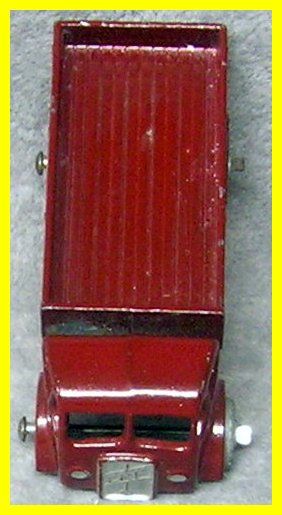
George T.
That’s not a bad idea, but it does have the shortcoming of not addressing why the variation stopped occurring. (As far as I know, all the spare wheel examples known are silver-trimmed, maroon models. Perhaps dedicated wheel tumblers were introduced as the range, and production, increased?)shockwavetrading wrote:Although not tumbled at the same time, it seems feasible to me that the same machine could be used. And that, considering its size, the odd wheel may get left behind in the tumbler and therefore mixed in with the next batch of items.
You are right, some British lorry spare wheels were commonly stored horizontally between the axles on the opposite side of the fuel tank or at the rear under the overhang. But we all have some RW71a which shows this behind the cab spare wheel arrangement which was not unknown on army trucks and some ERF models including the V type which we have here as 20a -tried googling up photos of the 1:1 but all they show is no visible spare wheel on either side or rear end!!!Idris wrote:Mick makes some interesting points, but I think another argument against it being deliberate is that, in real life, you wouldn't fit the spare wheel between the cab and the backboard since it would be extremely difficult to get it up/down. I may be wrong, but I think 1950s lorry spares were normally stored horizontally, suspended from the chassis either between the two axles or to the rear of the rear axle.
Furthermore, having found the model without brace to be too weak to stand up to playwear (we know this from the pale green versions that have been found), it seems odd that Lesney would add a brace and a spare wheel, especially since the latter would cost money.
Although it very much looks the part and much as I would like to believe that it is a deliberate variation, I think that odds are that the acceped position on these is correct: it is merely an error piece caused by tumbling wheel and body castings together.
If we assume that Lesney used wheels as part of the body casting tumbling process then the wheels could have been recovered simply by sieving the castings, a process which would have already removed flash with a finer sieve!Tinman wrote:When this model was made, "collector clubs" were not organized like they were in the 60s and later 70s. I learned (can't remember from whom or where) that some of the very early models had the metal wheels cast in the same mold as the body parts. I suspect this process had changed by the time the 20a was in production. Putting the wheels into tumble with the body parts was an excellent (and smart) process, the wheels served as a medium to beter polish off the flash and body parts. It has always been considered accidential that some wheels became lodged in place behind the bed's headboard.
There were "spare wheels" on models before this one and after this one. All of them were designed with a method to affix the wheel or tire. None of them ever had a wheel jammed into a random opening in the body and none of them were painted the same color as the model. The evidence clearly points to accidental placement during tumbling (fettling).
Evidence?SMS88 wrote:It may in fact just be a coincidence that some 1:1 1950s & 1960s ERFs had spare wheels mounted behind the cab like this